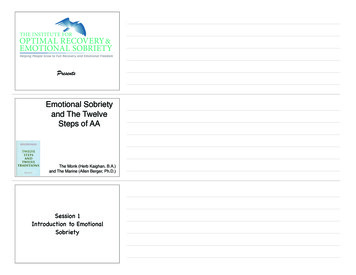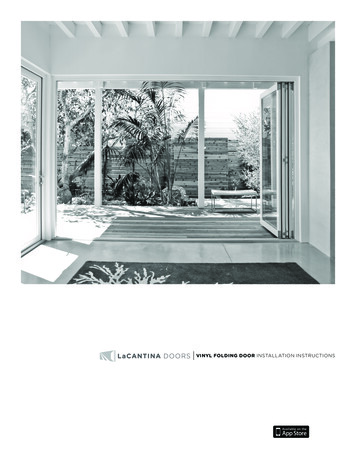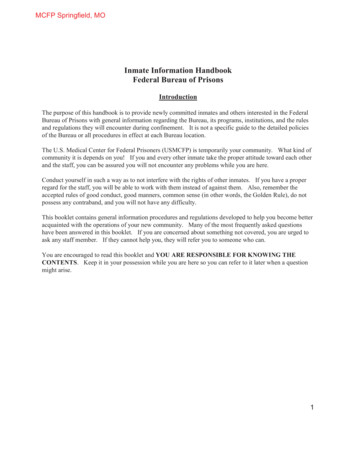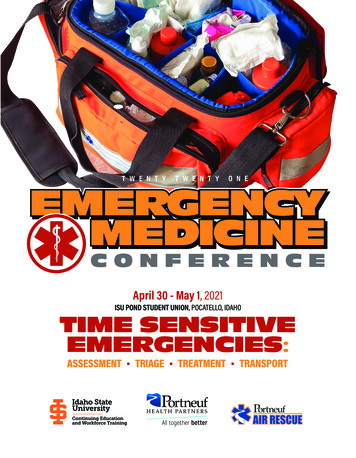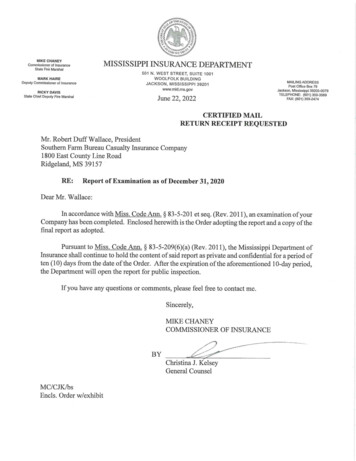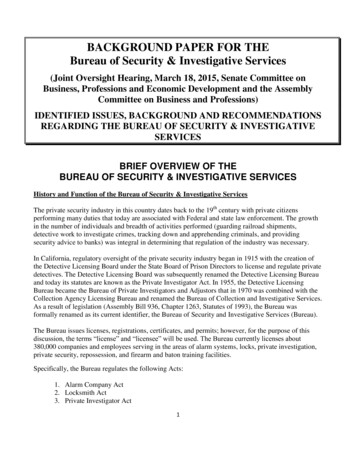
Transcription
First Step ActInitial Review of the SPARC-13Needs Assessment SystemU.S. Department of JusticeFederal Bureau of PrisonsWashington, DC
Table of ContentsIntroduction to the Initial Review of the Needs Assessment . 3Formal Beginnings of the Needs Assessment . 5Continuous Improvement of the Needs Assessment . 8Case Study.10Outcome Data .11Corrective Actions .16Future Year Validation Studies .17Needs Assessment Process.19Needs AreasAnger/Hostility.20Antisocial Peers.21Cognitions.22Dyslexia 27Medical .28Mental Health .29Recreation/Leisure/Fitness.30Substance Use.31Trauma .32Work .33Evidence-Based Recidivism Reduction Programs & Productive Activities by Need Area . 34BOP First Step Act Needs Assessment Self-AuditInmate Interview Form .39Staff Interview Form .42Case File Review Form .45March 20222
Introduction to the Initial Review of the Needs AssessmentThe First Step Act (FSA) requires annual review and validation of the risk and needsassessment system. Per section 101 of FSA, codified at 18 § U.S.C. § 3631, 1 “The AttorneyGeneral shall on an annual basis, review, validate, and release publicly on the Departmentof Justice website the risk and needs assessment system.” The risk-need-responsivity (RNR)model first formally articulated by Andrews, Bonta, and Hoge (1990, 19-52) 2 has developedinto the gold standard for effective assessment and intervention within the correctionalpopulation. In line with the mission of the Federal Bureau of Prisons (BOP) to “protect societyby confining offenders in the controlled environments of prisons and community-basedfacilities that are safe, humane, cost-efficient, and appropriately secure, and that providework and other self-improvement opportunities to assist offenders in becoming law-abidingcitizens,” 3 RNR aims to promote public safety and provides opportunities for inmates toaddress identified needs through targeted interventions. 4 The BOP modeled its risk andneeds assessment system on the industry standard for addressing recidivism.Per Andrews and Bonta (2016), 5 the risk principle of RNR involves matching the intensity ofservices with the likelihood of reoffending. Consistent with the language of the First Step Act,high- and medium-risk inmates receive priority treatment placement. The need principleassesses identified criminogenic needs; identified needs should be the target of interventionsto reduce recidivism. The responsivity principle involves general and specific responsivity andincludes maximizing the inmate’s ability to learn by tailoring services to individualcharacteristics. In sum, RNR theorizes that risk and needs should direct the strategies foraddressing identified criminogenic factors. 6As an essential part of RNR, the need principle relies on dynamic assessment of risk factors 7using validated tools. 8 Accurately identifying needs and providing associated treatment1Entire First Step Act available at 5publ391.pdf.2 D. A. Andrews, James Bonta, and R. D. Hoge, “Classification for Effective Rehabilitation: Rediscovering Psychology,” Criminal Justice andBehavior 17, no. 1 (1990): 19-52, al Bureau of Prisons, “About Our Agency: Pillars,” accessed August 8, 2021, https://www.bop.gov/about/agency/agency pillars.jsp.4 Tony Ward, Joseph Melser, and Pamela M. Yates, “Reconstructing the Risk-Need-Responsivity Model: A Theoretical Elaboration andEvaluation,” Aggression and Violent Behavior 12, no. 1 (2007): 208-228, https://doi.org/10.1016/j.avb.2006.07.001.James Bonta and D. A. Andrews, The Psychology of Criminal Conduct, 6th ed. (New York: Routledge, 2016),https://doi.org/10.4324/9781315677187.5Faye S. Taxman, April Pattavina, and Michael Caudy, “Justice Reinvestment in the United States: An Empirical Assessment of the PotentialImpact of Increased Correctional Programming on Recidivism,” Victims and Offenders 9, no. 1 (2014): .67 Matthew Makarios and Edward J. Latessa, “Developing a Risk and Needs Assessment Instrument for Prison Inmates: The Issue of Outcome,”Criminal Justice and Behavior 40, no. 12 (2013): 1449-1471, https://doi.org/10.1177/0093854813496240.8 Faye S. Taxman and Lindsay Smith, “Risk-Need-Responsivity (RNR) Classification Models: Still Evolving,” Aggression and Violent Behavior 59(2021), https://doi.org/10.1016/j.avb.2020.101459.March 20223
interventions increases the probability that inmates will acquire the skills necessary forsuccessful reentry into society.The BOP strives to maintain compliance with all statutory requirements and accomplishedfull implementation of the needs assessment system and facilitated program enrollmentamong its inmate population ahead of statutory requirements. This needs assessmentsystem, made of 13 component parts, was put into use and completed for all sentencedinmates in January 2020, and it continues to be used system-wide for all sentencedinmates.This document delineates all the work BOP has engaged in to produce a valid needsassessment system, offers early outcome data, and provides a preview of the BOP’s nextsteps.March 20224
Formal Beginnings of the Needs AssessmentThe BOP has long-standing procedures for assessing needs as part of the intake process, withreassessment occurring at least semi-annually throughout an individual’s incarceration. Withthe passage of the FSA, the BOP turned its attention to formalizing and enhancing the needsassessment system. Although the FSA allows two years from the release of the risk and needsassessment system to complete this process, the BOP implemented a series of systemicimprovements in 2019 and 2020 in furtherance of this goal.In September 2019, the BOP convened a needs assessment symposium. Attendees includedrepresentatives from the BOP, the Department of Justice (DOJ), and the IndependentReview Committee (IRC), as well as academic scholars and correctional leadersrepresenting departments with strong needs assessment systems. As a result of this gathering,12 clearly defined needs are assessed under BOP’s system. Twelve needs were identified bythe expert group: Anger/Hostility, Antisocial Peers, Cognitions, Education, Family/Parenting,Finance/Poverty, Medical, Mental Health, Recreation/Leisure/Fitness, Substance Use,Trauma, and Work. A thirteenth need, Dyslexia, is statutorily required by the First Step Act.Measures or data sources for the assessment of each need were adopted or formalized. Forneeds that rely on historical data, information is drawn from the comprehensive legal andsocial history in the Presentence Investigation Report (PSR) completed by United StatesProbation Officers. The PSR is a structured report required by law to be conducted by a U.S.Probation Officer prior to a defendant’s sentencing. 9 The goal of the report is to enable thesentencing court to make “a fair sentencing decision and assist corrections and communitycorrections officials in managing offenders under their supervision.” 10 This narrativedocument contains a wealth of information from a multitude of sources including existingcriminal history records, educational systems, hospitals and counseling centers, familymembers, associates, and others who corroborate records and reports. By virtue of thisinvestigative report, certain needs may be identified.Other needs require psychological or educational assessments, and the tools used to assessthem are delineated below. Each of these tools was selected based on a thorough reviewof the research literature and in consultation with both experts internal to the BOP and thosebased at universities. The IRC includes in its membership a professor well-published in thissubject area, and her expert consultation was sought as well. Several citations, offered asfootnotes herein, provide examples of studies of the various tools, including theirdevelopment and validation.918 U.S.C. § 3552.10 Office of Probation and Pretrial Services, Administrative Office of the United States Courts, Publication 107, “The Presentence InvestigationReport” (Rev. March 2006) p. I-1; /02/26/Horvath presentence.pdf.March 20225
The Anger/Hostility need is assessed by the Brief Anger-Aggression Questionnaire 11(BAAQ) and is intended to measure levels of overt anger and aggression. The BAAQ isa reliable and valid six-item questionnaire that yields a score between 0 and 24. Fourstudies 12 were completed on a clinical outpatient population and on a nonviolentcontrol sample to determine validity and reliability. Results suggested an acceptablelevel of consistency over time and competency in its measurement of levels of overtanger and aggression. The BAAQ offers potential as a screening tool through its abilityto rapidly provide a general estimate of anger dyscontrol. 13 The Antisocial Peers need and Cognitions need are assessed by the Measures ofCriminal Attitudes and Associates 14 (MCAA). The MCAA is a two-part self-reportmeasure of criminal thinking style and antisocial associates. Part A is a quantified selfreport measure of antisocial associates. Part B contains four attitude scales: Violence,Entitlement, Antisocial Intent, and Associates. The MCAA has demonstrated significantassociations with other measures of criminal thinking style 15 and predictive validity forthe outcomes of general and violent recidivism. 16 The Dyslexia need must be assessed with measures to meet certain specifications, perthe FSA to identify persons with dyslexia. The BOP instituted a two-phase screeningprocess. First, all inmates complete a screening instrument that examines symptomsacross statutorily defined functional domains. Inmates who reach the threshold arethen administered the Woodcock Johnson IV, a psychometrically robust test capableof formal diagnosis. The Education need is assessed to determine the presence or absence of a high schoolequivalence. Measures used for assessing achievement on core content areas are theTest of Adult Basic Education (TABE) and Comprehensive Adult Student AssessmentsSystem (CASAS), which is used exclusively for English as a Second Language learners. The Family/Parenting need is assessed to determine one's beliefs about their family'sreliability, supportiveness, and acceptance. The assessment is carried out using theFamily Assessment Device 17 (FAD-12). FAD-12 is a 12-item, Likert-scale questionnairerelated to an individual’s perception of their family’s relationships. This measure has11 Ronald R. Mauiro, Peter P. Vitaliano, and Timothy S. Cahn, “A Brief Measure for the Assessment of Anger and Aggression,” Journal ofInterpersonal Violence 2, no. 2 (1987): 166-178, 13 George F. Ronan et al., Practitioner's Guide to Empirically Supported Measures of Anger, Aggression, and Violence (New York: Springer,2014), https://doi.org/10.1007/978-3-319-00245-3.Jeremy F. Mills and Daryl G. Kroner, Measures of Criminal Attitudes and Associates User Guide (Kingston, Ontario, self-pub., emy F. Mills, Daryl G. Kroner, and Adelle E. Forth, “Measures of Criminal Attitudes and Associates (MCAA): Development, FactorStructure, Reliability and Validity,” Assessment 9, no. 3 (2002): 240-253, https://doi.org/10.1177/1073191102009003003.1516 Jeremy F. Mills, Daryl G. Kroner, and Toni Hemmati, “The Measures of Criminal Attitudes and Associates (MCAA): The Prediction of Generaland Violent Recidivism,” Criminal Justice and Behavior 31, no 6 (2004): 717-733, https://doi.org/10.1177/0093854804268755.17 Nathan B. Epstein, Lawrence M. Baldwin, and Duane S. Bishop, “The McMaster Family Assessment Device,” Journal of Marital and FamilyTherapy 9, no. 2 (1983): 171-180, .March 20226
been utilized in a variety of settings 18. It is considered a dynamic measurement andcan be re-administered at various points throughout the course of treatment to assessimprovements in the nature of the individual's family relationships and to evaluate theeffectiveness of therapeutic interventions. The Finance/Poverty need is assessed to determine an individual’s financial deficitsand is accomplished through a series of questions and information drawn from thePresentence Investigation Report. The Medical need is assessed to determine if an individual has any of acute medicalconcerns. The assessment is performed through a history and physical conducted by amedical practitioner at a BOP institution. The intake screening serves as an assessmentof acute medical concerns; the initial physical examination consists of, but is not limitedto, the following components: medical and mental health, dental care, and orderingof appropriate laboratory and diagnostic tests. The Mental Health need is assessed by requesting key mental health information insupport of effective triage and long-term care. The assessment is operationalized bythe diagnoses and frequency of services (using the BOP’s established mental healthcare level system) that are identified via the Psychology Services Inmate Questionnaire(PSIQ). The PSIQ is a structured interview tool developed by the BOP and functions asa self-report instrument delivered to inmates upon arrival to an institution. Inmates areasked a series of questions that allow staff to identify a need for crisis care (e.g., suicideideation), acute care (e.g., anxiety, distress), and historical conditions that wouldprompt routine care (e.g., history of mental health treatment). 19 The Recreation/Leisure/Fitness need is assessed to assure that individuals with ongoingmedical needs can be tracked and seen by a health care provider at clinicallyappropriate intervals. 20 The assessment is determined through participation in achronic care clinic. Chronic care clinics (CCCs) are an agency-wide categorizationand standardization tool. The Substance Use need is assessed to determine individuals in need of substanceabuse treatment. The assessment is carried out in part by review of substance useinformation presented in the Presentence Investigation Report. Substance useoccupies its own section in the PSR, and it provides an overview of an inmate’s recentand remote substance use history. 21 Additional assessment occurs via interviews withdrug treatment staff. The Trauma need is assessed to determine if an individual has experienced trauma thatmay pose a risk for negative behavior. The assessment is carried out using the Adverse18 Robert I. Kabacoff et al., “A Psychometric Study of the McMaster Family Assessment Device in Psychiatric, Medical, and NonclinicalSamples,” Journal of Family Psychology 3, no. 4 (1990): 431-439, https://doi.org/10.1037/h0080547.19For complete access to P5310.17, visit https://www.bop.gov/policy/progstat/5310 017.pdf.20For complete access to P6031.04, visit https://www.bop.gov/policy/progstat/6031 004.pdf.21Office of Probation and Pretrial Services, “The Presentence Investigation Report,” II-8.March 20227
Childhood Experiences Scale (ACES). Developed by Felitti and colleagues (1998), 22 theAdverse Childhood Experiences Scale (ACES) is a widely used 23 and reliable 24 tool thatmeasures childhood exposure to trauma: psychological, physical, or sexual abuse,neglect, mental illness, domestic violence, divorce, and having a parent in prison.Adverse childhood experiences were found to be associated with significant increasesin several negative social, behavioral health, and physical health outcomes. The Work need is assessed through a series of questions and information drawn fromthe Presentence Investigation Report.Inmates complete the assessments for Anger/Hostility, Antisocial Peers, Cognitions, andFamily/Parenting on the BOP’s inmate computer system (see Figure 1 for a graphicrepresentation of the needs assessment process). Inmates are advised of the assessments atAdmission and Orientation 25 and are reminded of the assessments at intake with PsychologyServices. Additionally, the inmate computer system has a bulletin that details the availabilityof the assessments. Health Services is responsible for assessment of the Medical andRecreation/Leisure/Fitness needs as part of the intake process. Education staff assessDyslexia, Education, and Work as part of the intake process. Unit Management assessesSubstance Use during initial intake and Finance/Poverty at the first team meeting.Psychology Services is responsible for the remaining needs areas: Trauma and Mental Health,which are assessed as part of the intake process.Continuous Improvement of the Needs AssessmentThe BOP has taken important steps to improve the needs assessment system during its initialimplementation. As part of building the technology infrastructure, the BOP implementedtracking systems to ensure proper recording of information. Unique identifiers were createdin the agency’s inmate management database for each approved program; when aninmate signs up for, participates in, and completes the program the information is recordedand archived. The BOP’s case management tool, Insight, has been modified to displayneeds assessment information; the BOP’s inmate management and case managementsystems are integrated so that needs entered in either system will display in both systems.These assignments allow the BOP to run nationwide rosters of every need, for the eventualevaluation of both staffing resource needs and program capacity.Vincent J. Felitti et al., “Relationship of Childhood Abuse and Household Dysfunction to Many of the Leading Causes of Death in Adults:The Adverse Childhood Experiences (ACE) Study,” American Journal of Preventive Medicine 14, no. 4 (1998): 7-8.22Robert H. Stensrud, Dennis D. Gilbride, and Robert M. Bruinekool, “The Childhood to Prison Pipeline: Early Childhood Trauma as Reportedby a Prison Population,” Rehabilitation Counseling Bulletin 62, no. 4 (2019): 195-208, https://doi.org/10.1177/0034355218774844.2324 Ricardo Pinto, Liliana Correia, and Ângel Maia, “Assessing the Reliability of Retrospective Reports of Adverse Childhood Experiencesamong Adolescents with Documented Childhood Maltreatment,” Journal of Family Violence 29, no. 4 (2014): 9.25For complete access to P5290.14, visit https://www.bop.gov/policy/progstat/5290 014.pdf.March 20228
This improved needs assessment system, collectively known as the Standardized PrisonerAssessment for Reduction in Criminality (SPARC-13), was launched in January 2020 andmemorialized in BOP Program Statement 5400.01 (PS 5400.01), 26 First Step Act NeedsAssessment, issued on June 25, 2021. In January 2020, every inmate in BOP custody for over28 days was provided with the individualized results of their risk and needs assessment, andinmates began enrolling in programs designed to address identified needs.Practically, PS 5400.01 directs the new needs assessment process (see Figure 1 for a graphicrepresentation of the needs assessment process), outlining staff responsibilities and providingtimeframes for initial needs assessment and reassessment. Inmates are screened at theBOP’s Designation & Sentence Computation Center (DSCC) and are designated to aninstitution that addresses security level and basic needs. Once at their designated facility,inmates attend Admission and Orientation where they become acclimated with theprograms the institution has to offer. Per BOP Program Statement 5322.13, InmateClassification and Program Review, 27 inmates receive an initial risk assessment by UnitManagement within 28 calendar days of designation; Education, Health Services,Psychology Services, and Unit Management conduct needs assessments as part of theirrespective intake processes. Once needs are assessed, Unit Management, in consultationwith other departments, make program recommendations to the inmate that are targetedtoward identified needs areas. The needs assessment process was designed to bestandardized across inmates and to be dynamic and flexible to incorporate individualizedplanning; needs are reassessed at least every 180 calendar days by Unit Managementduring the routine program review (team meeting) process to account for change ofcircumstances, e.g., receipt of an incident report or completion of an EBRR or PA.Reassessment results are relayed by Unit Management to inmates during the team meeting;results of the reassessment are cataloged in inmates’ electronic central file. This informationis used in ongoing planning with the inmate, particularly regarding program referrals.In collaboration with the IRC and DOJ, the BOP published a list of more than 70 EvidenceBased Recidivism Reduction (EBRR) programs and Productive Activities (PAs) in January2020, 28 the most robust of which are Cognitive Behavioral Therapy (CBT) interventions formental health and substance use disorders, anger management, and criminal thinkingminimization. Literacy and nearly 200 occupational training programs are also widelyavailable, and reentry-focused programs such as parenting are offered at all sites. Everyprogram is mapped onto the needs it addresses. The entire goal of a needs assessment is todetermine what goals and associated services should be set for each individual inmate.Thus, based on the findings, inmates discuss with staff the best ways they can target theareas identified as warranting improvement. This is generally done by the inmate completinga program or other associated task. Because of criminal thinking errors prevalent among theinmate population, the BOP has long offered incentives for the most intensive programs to26For complete access to P5400.01, visit For complete access to P5322.13, visit https://www.bop.gov/policy/progstat/5322 013.pdf.28 The list of programs and activities has been expanded to over 85; the most recent version of First Step Act Approved Programs Guide isavailable at https://www.bop.gov/inmates/fsa/docs/fsa program guide 2201.pdf.March 20229
encourage inmates to participate. Incentives were expanded under the FSA, and when aninmate completes a recommended program in an identified need area, they may be ableto earn time credit or other desired tangibles. 29 The time credit rule was finalized in January2022; 30 the policy for other desired incentives was issued July 14, 2021.As one of the largest employers of doctoral level psychologists, as well as an employer ofchaplains, teachers, and medical professionals, the agency is well-suited to identify gaps inprogramming and create services grounded in evidence that fit federal correctionalpopulation parameters. The BOP has expanded upon its initial FSA program offerings, andnow provides over 85 structured EBRR programs and PAs to inmates across disciplines thatcover all 13 need areas. Programmatically, the agency’s focus continues to be on programfidelity and building capacity of existing programs.Case StudyThe following fictional information is based on the experience of actual individuals using theneeds assessment system (see Figure 1 for a graphic representation of the needs assessmentprocess). It is provided for the purpose of illustrating how the tools are part of the largerincarceration process.Inmate Smith was sentenced to 120 months for a drug-related offense. When he arrives atthe facility where he is to serve his sentence, he receives an informational handbook, basicproperty, and a medical screening. A few days later, he attends an Admission andOrientation session where staff from several different departments introduce themselves andexplain their functions. Here, he learns in more detail about some of the programs andservices available to him as well as general security procedures and institution operations.Later, in his housing unit, inmate Smith logs into an available computer to check his emailand sees that he has been asked to complete several questionnaires. He completes the oneabout his family, but then he decides to go play cards before dinner. The next day he isasked to go to an appointment in Psychology Services to complete a mental healthscreening. While there, he is reminded to complete the remaining questionnaires on thecomputer. He asks the psychologist why he should spend the time on this; he does not seethe value. Because she is trained in motivational interviewing, 31 she explores his reasons forresisting the direction while gently challenging him using open-ended questions. He agreesto complete the assessment. He goes back to the housing unit and answers the remainingquestions, which takes him about 15 minutes.29For complete access to P5220.01, visit For complete access to FSA Time Credits, visit 19/2022-00918/fsa-time-credits.31 Stephen Rollnick, William R. Miller, and Christopher C. Butler, Motivational Interviewing in Health Care: Helping Patients Change Behavior(New York: The Guilford Press, 2008).March 202210
While the inmate is completing his remaining assessments, staff in Education and his UnitManagement are also reviewing information about the inmate and using various tools tocomplete assessments with this information. They load the information directly into the BOP’sinmate management database, while the inmate’s self-reported results are sent for scoringand staff entry into the system as well.Within four weeks, Unit Management meets with inmate Smith. They explain to him the resultsof the SPARC-13 assessments. He is not surprised to learn he is recommended to completesubstance use treatment and engage in family programming.Outcome DataPrior to the enactment of the FSA, most inmate needs were assessed upon request of theinmate; many programs were provided based on request rather than need. This allowedmotivated and insightful inmates to thrive but did not clear a path to success for inmateswho were less motivated or willing to explore strategies to address their needs. During thetwo-year phase-in period, the BOP focused on implementing the needs assessment systemfor all inmates. This report documents such efforts through the production of initial data. It isanticipated significantly more extensive data will be available for analysis in future reports.The BOP’s systematic approach to data collection and reporting under the FSA supportedthe assessment of 155,551 inmates over fiscal year 2021. Of the total number of assessmentscompleted, 113,779 inmates had all 13 assessments completed as part of the BOP’s SPARC13 system.Table 1. Number of inmates assessed by sexFrequencyFemale10,916Male144,591Frequency Missing 44Table 2. Number of inmates assessed by raceFrequencyAsian2,237Black60,515Native American4,176White88,579Frequenc
full implementation of the needs assessment system and facilitated program enrollment among its inmate population ahead of statutory requirements. This needs assessment system, made of 13 component parts, was put into use and completed for all sentenced inmates in January 2020, and it continues to be used system-wide for all sentenced inmates.

